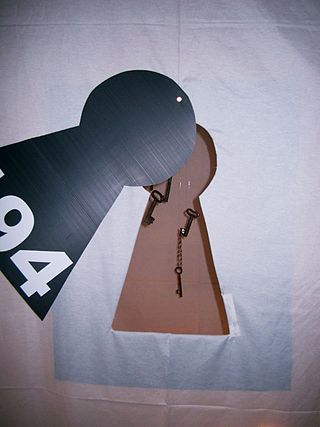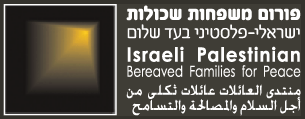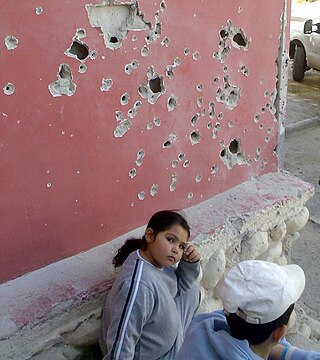Related Research Articles

Yasser Arafat was a Palestinian political leader. He was Chairman of the Palestine Liberation Organization (PLO) from 1969 to 2004 and President of the Palestinian National Authority (PNA) from 1994 to 2004. Ideologically an Arab nationalist and a socialist, Arafat was a founding member of the Fatah political party, which he led from 1959 until 2004.

The Israeli–Palestinian conflict is an ongoing military and political conflict in the Levant. Beginning in the mid-20th century, it is one of the world's longest-continuing conflicts. Various attempts have been made to resolve the conflict as part of the Israeli–Palestinian peace process, alongside other efforts to resolve the broader Arab–Israeli conflict. Public declarations of the desire to see a Jewish homeland established in Palestine, including the First Zionist Congress of 1897 and the Balfour Declaration of 1917, created early tensions in the region after waves of Jewish immigration. Following World War I, the Mandate for Palestine included a binding obligation for the "establishment in Palestine of a national home for the Jewish people". Tensions grew into open sectarian conflict between Jews and Arabs. The 1947 United Nations Partition Plan for Palestine was never implemented and provoked the 1947–1949 Palestine War. The current Israeli-Palestinian status quo began following Israeli military occupation of the West Bank and Gaza, known as the Palestinian territories, in the 1967 Six-Day War.

Neve Shalom, also known as Wāħat as-Salām is a cooperative village in Israel, jointly founded by Israeli Jews and Arabs in an attempt to show that the two peoples can live side by side peacefully, as well as to conduct educational work for peace, equality and understanding between the two peoples. The village is located on one of the two Latrun hilltops overlooking the Ayalon Valley, and lies midway between Tel Aviv and Jerusalem. Falling under the jurisdiction of Mateh Yehuda Regional Council, in 2021 it had a population of 356.

The Second Intifada, also known as the Al-Aqsa Intifada, was a major uprising by Palestinians against the Israeli occupation, characterized by a period of heightened violence in the Palestinian territories and Israel between 2000 and 2005. The general triggers for the unrest are speculated to have been centred on the failure of the 2000 Camp David Summit, which was expected to reach a final agreement on the Israeli–Palestinian peace process in July 2000. An uptick in violent incidents started in September 2000, after Israeli politician Ariel Sharon made a provocative visit to the Al-Aqsa compound, which is situated atop the Temple Mount in East Jerusalem; the visit itself was peaceful, but, as anticipated, sparked protests and riots that Israeli police put down with rubber bullets and tear gas.

Arab–Israeli peace projects are projects to promote peace and understanding between the Arab League and Israel in different spheres. These are part of a broader attempt at a peace process between Palestinians and Israelis. Sponsors of such projects can be found both in Israel and Palestine.

The 2000 Camp David Summit was a summit meeting at Camp David between United States president Bill Clinton, Israeli prime minister Ehud Barak and Palestinian Authority chairman Yasser Arafat. The summit took place between 11 and 25 July 2000 and was an effort to end the Israeli–Palestinian conflict. The summit ended without an agreement and its failure is considered one of the main triggers of the Second Intifada.

Rachel Aliene Corrie was an American activist and diarist. She was a member of the pro-Palestinian International Solidarity Movement (ISM) and was active throughout the Palestinian territories. In 2003, Corrie was in Rafah, a city in the Gaza Strip, where the Israeli military was demolishing Palestinian houses at the height of the Second Intifada. In an attempt to stop the demolitions as they were being carried out, she stood in front of an armored bulldozer and was subsequently crushed to death by it under contested circumstances.
The International Solidarity Movement is a Palestinian-led movement focused on assisting the Palestinian cause in the Israeli–Palestinian conflict. ISM is dedicated to the use of nonviolent protests and methods only. The organization calls on civilians from around the world to participate in acts of nonviolent protests against the Israeli military in the West Bank and the Gaza Strip.

The Israeli West Bank barrier, comprising the West Bank Wall and the West Bank fence, is a separation barrier built by Israel along the Green Line and inside parts of the West Bank. It is a contentious element of the Israeli–Palestinian conflict: Israel describes the wall as a necessary security barrier against Palestinian political violence, whereas Palestinians describe it as an element of racial segregation and a representation of Israeli apartheid. At a total length of 708 kilometres (440 mi) upon completion, the route traced by the barrier is more than double the length of the Green Line, with 15% of its length running along the Green Line or inside Israel, and the remaining 85% running as much as 18 kilometres (11 mi) inside the West Bank, effectively isolating about 9% of the land and approximately 25,000 Palestinians from the rest of the Palestinian territory.

Media coverage of the Arab–Israeli conflict by journalists in international news media has been said to be biased by both sides and independent observers. These perceptions of bias, possibly exacerbated by the hostile media effect, have generated more complaints of partisan reporting than any other news topic and have led to a proliferation of media watchdog groups.

In 2005, 21 Israeli settlements in the Gaza Strip were unilaterally dismantled and Israeli settlers and army evacuated from inside the Gaza Strip.

Ilan Pappé is an Israeli historian, political scientist and politician. He is a professor with the College of Social Sciences and International Studies at the University of Exeter in the United Kingdom, director of the university's European Centre for Palestine Studies, and co-director of the Exeter Centre for Ethno-Political Studies.

The Palestinian right of return is the political position or principle that Palestinian refugees, both first-generation refugees, as well as their descendants, have a right to return and a right to the property they themselves or their forebears left behind or were forced to leave in what is now Israel and the Palestinian territories, as part of the 1948 Palestinian expulsion and flight, a result of the 1948 Palestine war, and due to the 1967 Six-Day War.

In 1948, more than 700,000 Palestinian Arabs – about half of prewar Mandatory Palestine's Arab population – fled from their homes or were expelled by Zionist militias and, later, the Israeli army during the 1948 Palestine war, following the Partition Plan for Palestine. The expulsion and flight was a central component of the fracturing, dispossession, and displacement of Palestinian society, known as the Nakba. Between 400 and 600 Palestinian villages were destroyed. Village wells were poisoned in a biological warfare programme and properties were looted to prevent Palestinian refugees from returning. Other sites were subject to Hebraization of Palestinian place names. These activities were not necessarily limited to the year 1948.

The Parents Circle-Families Forum is a grassroots organization of Palestinian and Israeli families who have lost immediate family members due to the conflict. The PCFF operates under the principle that a process of reconciliation is a prerequisite for achieving a sustained peace. The PCFF is also known as Israeli Palestinian Bereaved Families for Reconciliation and Peace and as Bereaved Families Supporting Peace, Reconciliation, and Tolerance.
Some families of Jews and Arabs killed in the Israeli-Arab conflict have chosen to donate organs to transplant patients on the "opposite side". Examples are Yoni Jesner, a 19-year-old student at Yeshivat Har Etzion in Gush Etzion, and Ahmed Khatib, a Palestinian boy shot by Israeli Defense Forces soldiers who mistook his toy gun for a real one. The generosity of families prepared to donate the organs of their loved ones under such circumstances has been praised. Their story was also made the subject of an award-winning BBC World Service program, Heart and Soul, in 2007.

The Israeli–Palestinian conflict has historically involved and affected children on both sides, dating back to events like the 1929 Hebron massacre and the 1948 Deir Yassin massacre, both of which have claimed the lives of children. Youth participation in hostilities increased notably during the First Intifada (1987–1993), with Palestinian children actively participating in protests against Israeli occupation. This period saw harsh responses from Israeli forces, leading to the arrest and detention of many Palestinian youths. The Second Intifada (2000–2005) was more violent, with a significant impact on children through involvement in protests and exposure to violence.
All for Peace was a joint Israeli-Palestinian East Jerusalem based radio station that transmitted from Ramallah in the Palestinian territories. It was founded in 2004 with the stated aim of having "a positive role in resolving the conflict" and describes itself as not-for-profit. A significant section of its independent revenue came from commercial advertising. It was the first radio station staffed by Israelis and Palestinians to be broadcast in both Arabic and Hebrew. The Israeli and Palestinian co-directors of the station were joint winners of the International Council for Press and Broadcasting's "Outstanding Contribution to Peace" award in 2010, part of the International Media Awards. The station was shut down by the Israeli government in November 2011 for "broadcasting into Israel illegally".
Rami Elhanan is an Israeli graphic designer and peace activist.
Return to Haifa is a novella written by Palestinian author and journalist, Ghassan Kanafani, mainly depicting Israel occupation over the Palestinian lands during the 1948 war in Haifa when Britain was in control of the land.
References
- ↑ Tracie Cooper (2012). "Another Side of Peace (2004)". Movies & TV Dept. The New York Times . Archived from the original on 25 October 2012. Retrieved 18 December 2009.